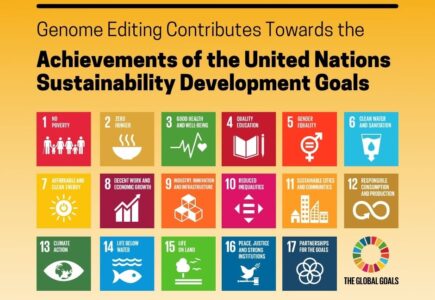Meeting the Sustainable Development Goals (SDG) requires innovation
Innovations in agriculture productivity between 2005 and 2015, greatly contributed to reductions in the number of people that were food insecure, which dropped from 810 million to 615 million. One of the innovations that had a significant contribution was the rapid global adoption of genetically modified (GM) crops during this period. This contributed to the United Nations (UN) #1 Millennium Development Goal in 2000 of reducing poverty. In 2015, the UN expanded its goals to an ambitious 17 targets for 2030, known as the Sustainable Development Goals (SDGs), with no poverty as their #1 SDG. Agriculture has tremendous potential to contribute to the SDGs, especially through increased adoption of new plant breeding technologies, such as those offered by genome editing. To identify the contributions of genome editing, I undertook an extensive review of how these technologies are able to contribute to the top three SDGs: 1) end poverty in all its forms, everywhere; 2) end hunger, achieve food security and improved nutrition and promote sustainable agriculture; and 3) ensure healthy lives and promote well-being for all at all ages. The article is freely available at: https://www.frontiersin.org/articles/10.3389/fgeed.2022.863193/full.
Addressing the SDGs
The top three SDGs are quite integrated, in that technologies that increase yield and nutrition also contribute to promoting health and reducing poverty. Genome editing technologies are being applied to increase the yields of the three global staple crops: corn, rice and wheat. Corn research includes applications to reduce the presence of toxins that can affect livestock when corn is fed to them and to increase yields by increasing the number of rows of kernels on a cob. Considerable research is underway throughout Asia and Africa to increase rice yields, as well as improve disease resistance, which can reduce yields by up to 40%. Yield and disease resistance enhancement are also important areas for wheat research, which has benefitted from the sequencing of its genome in 2020. Research is proceeding in many other food crops, such as citrus, vegetable and oilseed crops, with the leading traits including yield increases, increased disease and virus resistance and herbicide tolerance.
Complimenting yield increase research is the research that is concentrated on improving the nutritional content of food crops. Substantial research has been undertaken on improving nutritional quality that includes: enhanced protein (canola, corn, potato, rice, wheat); increased oils and fatty acids (canola, corn, rice, soy); improved carbohydrates (corn, potato, sugar beet, soy); increased vitamins (potato, rice, strawberry, tomato); and increased mineral availability (lettuce, rice, soy, corn, wheat). Numerous micronutrients, such as iron, zinc, selenium, magnesium, calcium and iodine, and vitamins like provitamin A and folate, play essential roles in the healthy development of children and the nutrition of nursing women. As well, vegetables are increasingly the focus of research addressed at increasing these vital nutritional compounds.
The research focused on improving the sustainability of crop and food production is a key part of the SDGs, and genome editing technologies are contributing to this area of research, such as improved water and nitrogen use efficiencies. Further research on increasing herbicide tolerance and insect resistance within crops is underway, which reduces the need for in-crop chemical applications.
Genome editing has limited applications in research designed to improve human health, but what has been commercialized thus far indicates that this area of research holds tremendous potential. Research involving tomatoes has produced fruit with increased aminobutyric acid which contributes to lower blood pressure, as well as increased lycopene, an antioxidant linked to lowering the risk of cancer and heart disease. Genome editing has been applied to reduce gliadin genes in wheat, creating the potential for new varieties that are safe for those with celiac disease (digestion disorder of gluten).
Integrating new crops that increase yields, farmer profitability, and human health and contribute to improved sustainability, collectively work to reduce poverty. One proven means of reducing extreme poverty is by increasing the rate of education. Increases in household income provide an opportunity for higher levels of child education. In some instances, malnourished children are unable to even attend school due to their physical weaknesses. Research on the importance of education and improved crop production shows that an additional four years of education can increase farm productivity by 8.7%.
The Green Revolution made tremendous advances in improved food security and reductions in starvation, malnutrition and poverty. Based on the rapidly increasing amount of research involving genome editing technologies in all aspects of crop and food research, significant potential exists that genome editing may provide benefits that rival those of the Green Revolution.
Smyth, S. J. (2022). Contributions of genome editing technologies towards improved nutrition, environmental sustainability and poverty reduction. Frontiers in Genome Editing, 4. https://doi.org/10.3389/fgeed.2022.863193


